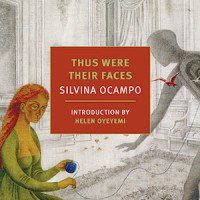“The world is not magical. We make it magical all of a sudden inside us, and nobody finds out until many years later.” So wrote Silvina Ocampo from her home in Buenos Aires in 1987. With the arrival this week, nearly 30 years later, of her magical collection of selected stories, Thus Were Their Faces, Ocampo’s earlier words resonate now with something of the “clairvoyance” Borges once attributed to her. Her hefty volume comes to us from New York Review Books (NYRB) Classics and features several stories translated into English for the first time by Daniel Balderston. This week, NYRB Poets also released Silvina Ocampo: Selected Poems translated by Jason Weiss. The poems make an insightful companion to her stories, reading like a much-polished, metered journal, covering some of the same territory that she explored in her stories.
Over the course of her lifetime and the greater part of the 20th century, Ocampo published seven books of short stories—the first, Forgotten Journey, in 1937, and the last, Cornelia Before the Mirror, in 1988. Clocking in at 42 stories and 354 pages, Thus Were Their Faces bears testimony to an extremely disciplined life’s work, containing at least a few stories (and often several) from each of her collections.
At a young age, Ocampo left Argentina for Paris, where she studied as a painter. This early training is reflected in the highly visual nature of her writing, which is not to call her language overly descriptive. In fact, her style is often quite spare and direct. Rather, like a surrealist painter, she liked to crowd the stage of her stories with unlikely companions in unexpected situations. In Ocampo’s visions, this play with the unexpected  became a way to elevate and amplify the fabulous while also exposing less-scrupulous and sometimes shocking everyday behaviors.
became a way to elevate and amplify the fabulous while also exposing less-scrupulous and sometimes shocking everyday behaviors.
Probably more than anything else, sheer curiosity propels readers through her stories. Elements of the supernatural and the weird permeate almost all of the 50-plus years worth of stories in Thus Were Their Faces. In “Magush,” people in a small town visit a forever-young boy to have him read their fortunes in the windows of an abandoned building. In “The Photographs,” a family drapes and arranges their paralyzed daughter in various poses to capture her immobile joy on her 14th birthday. In “The Velvet Dress,” a woman hoping to have some alterations made winds up instead being suffocated by a dress as our young narrator looks on and periodically exclaims, “How amusing!” In “Sheets of Earth,” a gardener becomes so deeply attuned to his work in the soil that he accidentally plants himself.
Given the surreal quality of the individual stories, it’s notable how linear the selected works reads from story to story, collection to collection, in some ways mimicking the stages of life. For example, the opening story, “Forgotten Journey” has a young girl “trying to remember the day she was born.” All her life, the girl’s nursemaid has led her to believe that before babies are born they live on shelves in a large department store in Paris until their mothers order them and come pick them up. When her mother contradicts this belief with talk of “flowers and birds,” she becomes a stranger to the girl. And when the girl looks out the window, rather than the sunny day her mother comments on outside, the girl sees a “dark sky of night where no bird sang.” The girl is the first of many young narrators that reign in Ocampo’s early stories, especially, who distrust the adult world of their parents and who face dark, alternative realities on their own.
“The Impostor,” a chilling novella first published in 1948 and here in English for the first time, begins with the teenager Luis Maidana riding a train on a mission akin to Patricia Highsmith’s talented Mr. Ripley. Namely, Luis’s father’s friend has sent him to monitor and send updates on the man’s son, Armanda Heredia. With the extra space that the novella allows, Ocampo braids in more character development and suspense than she achieves in her shorter stories, many of which are only a couple of pages long. As the title implies, “The Impostor” is a story of shifting and sometimes obscured identities. At the same time, it’s a regional story, set on a ranch near Cacharí, a sparsely populated, oh I’ll just say it, ghost town southwest of Buenos Aires. The rural landscape allows Ocampo to do what she does best, blurring the lines between waking life and dreams, the natural and the supernatural. At one point, contemplating the movements of a horse rumored to have been viciously blinded by Armanda, Luis says, “Animals are the dreams of nature.” It’s mind-blowing hallucinogenic lines like these that Ocampo casually tips our way that make it important to take the stories in small, slow doses lest we zip by and miss them.
“The Impostor” is one of those novellas that makes you wish that publishers were willing to put more of these mid-range  narratives out in the world all on their own—the perfect length for a short plane or train ride. Without giving away too much, fans of Adolfo Bioy Casares’s The Invention of Morel (1940) will probably appreciate the appended conclusion of “The Impostor.” In her novella, Ocampo plays at a strikingly similar ending structure, but I would argue she handles it to greater effect than Bioy Casares. Still, if anyone might have gotten permission to take such a liberty, it would probably be Ocampo, as the two were married for over 50 years.
narratives out in the world all on their own—the perfect length for a short plane or train ride. Without giving away too much, fans of Adolfo Bioy Casares’s The Invention of Morel (1940) will probably appreciate the appended conclusion of “The Impostor.” In her novella, Ocampo plays at a strikingly similar ending structure, but I would argue she handles it to greater effect than Bioy Casares. Still, if anyone might have gotten permission to take such a liberty, it would probably be Ocampo, as the two were married for over 50 years.
Speaking of marriage, several of the stories included from Ocampo’s The Fury (1959) and The Guests (1961) take marriage and extra-marital activities as their focus. These stories represent Ocampo twenty years into her writing career, a period some have identified as her prime and the era of her darkest stories. “Sometimes I think I can still hear that drum,” Octavio tells us in the opening line of “The Fury” as he gives a furtive look over his shoulder. Octavio has blood on his hands, but he is just one of many confessing their sins to us in these stories where Ocampo resurrects the idea of an earthly what-goes-around-comes-around-justice once meted out by the Furies in Greek mythology.
Note should probably be taken of the title story, “Thus Were Their Faces,” which draws its name from a verse in Ezekiel that appears as an epigraph to the story: “Thus were their faces: and their wings were stretched upward; two wings were joined one to another, and two covered their bodies.” The passage references four creatures that Ezekiel sees coming in on a “windstorm,” essentially a stylish entourage that precedes The Lord as he flits around Babylon. Ocampo’s title and epigraph leave off just how thus their faces were, but looking back up a few verses in the New International Version of the Bible, Ezekiel offers this explanation:
Their faces looked like this: Each of the four had the face of a man, and on the right side each had the face of a lion, and on the left the face of an ox; each also had the face of an eagle.
All of which adds up to some seriously Cubist-funkified faces that we can imagine Ocampo coming across and chuckling over as she takes a sip from her Fernet. Yes. I will write a story about that, she declares, scooting up to her typewriter.
Except she doesn’t, not quite. Instead, in “Thus Were Their Faces” she gives us something better, a first-person plural voice that slowly unwinds the mystery of a group of deaf schoolchildren: “Forty faces were exactly the same face, forty minds the same mind, despite differences in age and lineage.” It’s an eerie and troubling story of young schoolchildren the likes of which we don’t see again until Donald Barthelme’s “The School” in 1981. It’s the kind of gnawing collective story, like William Faulkner’s “A Rose for Emily,” that only a town can tell.
The selections from Ocampo’s penultimate collection, And So Forth (1987), give us some of her most playful work. Most notable is “The Music of the Rain,” which details a concert given by child prodigy pianist and eccentric Octavio Griber, who  travels around on a tour of private residences with his mother. Along with a biting, sarcastic humor, this story offers a cinematic quality that might inspire Wes Anderson. For example:
travels around on a tour of private residences with his mother. Along with a biting, sarcastic humor, this story offers a cinematic quality that might inspire Wes Anderson. For example:
The pianist sat down at the stool, placed his burning cigarette on the edge of the piano, and swung around several times in order to establish the correct height. He looked at his feet, the pedals, his feet, the pedals again, and then started playing scales with one of his big toes. The notes poured out in a most unusual staccato.
More than in any of her other writings, those from And So Forth seem to poke fun at the feelings of entitlement often attributed to the upper echelons of society. The aforementioned “Sheets of Earth” begins with a wealthy homeowner appreciatively watching her talented gardener from afar. Ocampo delivers this passing lady of leisure in her moment of joy thusly:
Sitting on the terrace, wrapped in the whiteness of her dress, she felt what all women dressed in white must feel on a beautiful day—she felt transparent and impersonal like the day itself, surrounded by crowds of flowers awaiting her.
If we are to follow the lifecycle of the stories we laid out earlier, we come to some more tortured and fatalistic questions in Ocampo’s last stories. From notes before and after the text, we know that Ocampo faced off with Alzheimer’s in her final years. This biographical note pulls at us with the confessional but not fully disclosed voice in “And So Forth.” Ocampo, who was married to Bioy Casares until her dying day, begins the story,
Loving someone isn’t enough. Perhaps out of fear of losing the one you love, you learn to love everything that surrounds him. The scarf he wore, his shirt, his handkerchief, the pillow with its faux vanilla beans where you both lay your heads… This whole world is a monument to our fidelity, because what is ours will never be found elsewhere without all the visions I have listed, symbols of the love that enslaves us. And if you go in search of a world without memories in order to forget, there is nothing that will block our eyes or our ears.
And probably, on this moving revelation, this is where we should find our end, where there is still the promise of love and mermaids and more of the magic that Ocampo spent a lifetime building up only to generously share with the English-speaking world now.




